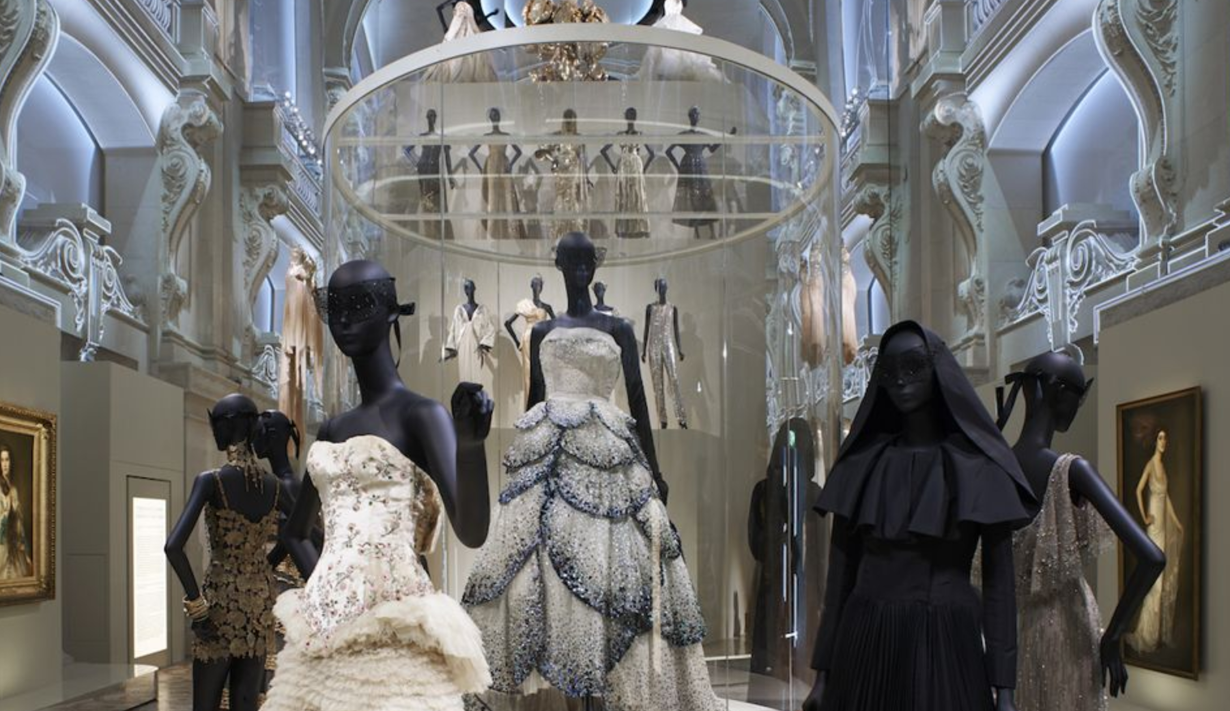
|
SUZY MENKES
School Of Christian DiorIs it possible for the work of a fashion artist to be reconstituted by a series of followers – after the original designer has left the stage? |
From Van Gogh to Matisse and Picasso, it would be impossible to imagine a 19th or 20th-century artist whose work was taken over completely by someone else, as opposed to that vague description ‘school of’.
Even Damien Hirst, with his team of assistants, summed up the importance of life in artistic work in the title of his pickled shark in 1991: The Physical Impossibility of Death in the Mind of Someone Living.
So how could Christian Dior, back in 1957, before his sudden and untimely disappearance at age 52, have imagined that his work – so personal, so tied up with artistic friends from his early years, so deeply and viscerally attached to his mother and her turn-of-the-century style – would generate a troop of six followers?
Some, like a young Yves Saint Laurent, the first replacement, went on to greater things. When Marc Bohan took over in 1960, he followed dutifully, if elegantly, for a long period in the founder's footsteps. Gianfranco Ferré, who took over in 1989, was rooted in his own Italian grandeur. The British/ Gibraltarian John Galliano was a wild card, rarely playing by the Dior rules until he was drummed out in disgrace in 2011, while Belgian Raf Simons (2012 – 2015) struggled for just three years with his own instinctive minimalism in the shadow of the floral flourishes of Monsieur Dior.
And finally, now, Maria Grazia Chiuri has brought a strong whiff of forceful feminism as an unlikely link with the shy Christian, a mother's boy.
Christian Dior: Designer of Dreams at the Musée des Arts Décoratifs in Paris (until 7 January 2018) aims to be an inexhaustible view of a designer brand with lasting power.
Yet it is only in the second half of this enormous tribute to the 70 years since the founding of the House of Dior that the six chosen acolytes are in full view, with displays of their designs with videos to bring them to life.
This sextet of those singing Dior's aria comes to a crescendo in a mighty, high-ceilinged room – looking like a Christian church (pun intended). It is all white, suggesting a heavenly atelier of teams of hand workers, with famous les petites mains of today working on a rota that brings them in from the actual couture atelier on Paris’s Avenue Montaigne to work in the museum.
Who was Christian Dior – and why did he become a mythical fashion character, with his name more instantly recognisable than lofty Balenciaga and on a par in fame only with Mademoiselle Chanel?
“The Dior brand is so famous, everybody knows the name and they did even in his first ten years,” said Maria Grazia, “I found this unbelievable book and realised that in 1954, after only seven years, he offered it in different languages with projects from scarves and socks to perfume. I never knew that he was so worldwide and that gave me another point of view of the brand.”
At the Paris museum, which has never before devoted both sides of its nave to a single exhibition in its 112-year history, the curatorship is also divided in two between Olivier Gabet, the Director of the Arts Décoratifs, and Florence Müller, Curator of Textile Art and Fashion at the Denver Art Museum in America.
Gabet leant towards the artistic side.
“We wanted to show the universe of the Maison Dior and how his inspiration is extremely sophisticated and cultivated,” he said. “What is important is that you have everything at the same level – a piece of couture and a great painting. You have to put them on the same scale and you soon have this line of art. Even before Galliano imposed himself as an artist, Mr Dior had created a visual culture, including 18th-century painting, Surrealism and Art Nouveau.”
So the museum, on its left side as you walk in, is devoted more to art history than to the endlessly promoted ‘Bar’ jacket that kicks off the second part of the exhibition. That fitted jacket and flaring skirt is now so entrenched in the Dior history that Melania Trump turned up in a Maria Grazia version during the recent presidential visit to Paris.
The show starts with a curvy, full-skirted red Diablesse dress from 1947 and an informative but dull visual history of the founder, on loan from the Dior museum in his birthplace Granville, Normandy. But it soon comes to life as we are introduced to the young Christian Dior, who apparently ignored the family business of farm fertilisation (shown on an advertising poster from the pre-war era) and hung out instead with his arty friends who included Christian Bérard, Georges Braque, Jean Cocteau and even Pablo Picasso himself.
Dior's father gave him money for investment on the condition that the family name was not included in the title of his art gallery. And although this dilettante period came to an abrupt end with the beginning of the Depression era, the museum has devoted a room to modernist art linked to Christian's own statement, “We were just a simple gathering of painters, writers, musicians and designers under the aegis of Jean Cocteau and Max Jacob.”
Alongside these pieces are other signs of fashion encompassing art in connection to photographers. They include Cecil Beaton's 1951 photograph of a luscious young Princess Margaret and the famous Richard Avedon Dovima with Elephants, Cirque d'Hiver, Paris, August 1955. These are displayed as digital projections which then fade to show the actual dresses behind.
Fine art, interspersed with vignettes of Dior's creations and those from the later designers are interspersed with ‘Colouramas’. They are visions, actual size or petite, of clothes and accessories, including distinctive high heeled shoes, displayed to promote a single colour. The result is both charming and artistic.
Significantly, the clothes from the later designers at Dior are within this introductory area. They are deliberately selected to fit in to the earlier Christian themes. This applies in particular to examples of the founder's love of gardens and flowers, especially his roses and favourite Lily of the Valley. A different around-the-world theme rather underscores the disparity between Dior's style and the urgency of Galliano’s designs or the modernism of Raf Simons’s work in conjunction with American artist Sterling Ruby.
Another introduction in this inexhaustible exhibition is to the witty furs of designer Frédéric Castet. His lush coat with an Eiffel Tower image, more like the leaning tower of Pisa, is inconceivable in modern times, but an interesting peek at how far the Dior offering stretched.
Sidney Toledano, Chief Executive of Christian Dior Couture was eager to point out that among many recent Dior exhibitions at home and abroad, this was the most important and ambitious presentation of the art, life and history of the designer. “For Paris, we have pushed the heritage to the limit with many new dresses and by displaying them with works of art,” said Toledano.
Would it have been enough if Christian Dior: Designer of Dreams had ended with the respectful addition of the satellite designers and a heart-warming look at the origin of the Miss Dior perfume? It was named for Christian's sister Catherine, who had worked for the French resistance, was captured and only escaped from imprisonment at the end of the war.
A letter written in April 1945 by Christian to his father concerning his sister's release from the Ravensbrück concentration camp is both moving and insightful, suggesting a depth of anguish behind the flower-strewn exterior.
When a designer label moves from the personal vision of its founder to a brand, there is inevitably a change of tone. Crossing the nave from family to the ‘school of Dior’ replacements, the display is less convincing as museum-worthy – especially as it ends with a ‘ballroom’ display of dresses that includes both those worn to the mythic 1951 event organised at the pinnacle of society by Charles de Beistegui
and gowns worn in the more recent celebrity era. Think of Princess Diana's Galliano dress at the Met Museum ball in 1996 or the pink gown worn by Jennifer Lawrence to the Oscars in 2013, when she famously tripped up.
The overall effect of the ‘The Dior Ball’, is dramatic, dynamic and sometimes steeped in social history – but it is more about entertaining the public than offering any suggestion of how and where Dior will move forward.
So, what is this mighty exhibition aiming to say? That Christian Dior today has grown from the roots planted by one poetic soul seven decades ago? That however different and disparate the aims of the following creators, it all comes back to Monsieur Dior?
There are many unanswered questions. Is this overall system of designer replacement, which Dior has lead, good for fashion? Or does it cream off emerging talents and oblige them to design according to an ever-more-distant master's voice?
As an increasing number of big names stagger on beyond the normal time of retirement, will their ultimate departures create a gulf which will need to be filled with yet more upcoming designers – when they should be free to create personal visions?
The show is stunning in many ways. But I left this huge display under the umbrella name of ‘Dior’ with more questions than in-depth answers about the legacy of the founder and where fashion goes, in the 21st century, from here.
WATCH
WATCH


